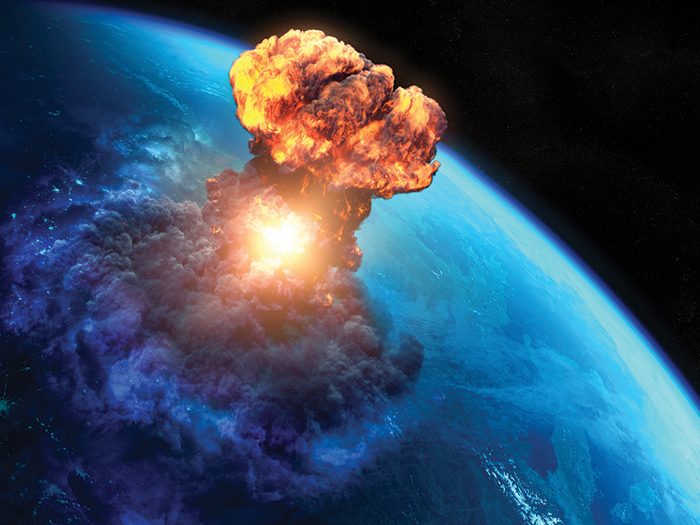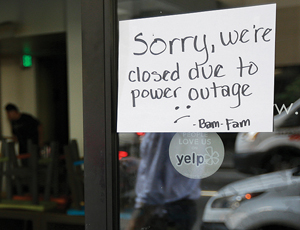Black Swan: EMP
Chaos From Above

Scenario
The vessel that seeks to undo America arrives in the teeth of a storm.
The 4,000-ton Indonesian freighter Pandawas Viper sails towards California in December 2017. It is shepherded toward North America by a fierce Pacific winter storm, a so-called “Pineapple Express,” boasting 15-foot waves and winds topping 70 mph.
Normally, Pandawas Viper carries cargo containers. This time she harbors a much more potent payload.
Unbeknownst to U.S. defense and intelligence officials, the Viper carries a single nuclear weapon, loaded onto a naval surface-to-air missile, or SAM, concealed below deck.
The warhead has an involved history. It was smuggled out of Kyrgyzstan in 1997, eventually finding its way into the hands of Islamic militants in Indonesia that are loosely affiliated with ISIS.
Even for these ambitious and murderous militants, outfitting a freighter with a nuclear device in secrecy and equipping it to sail to North America in the hopes of firing its deadly payload is quite an undertaking.
Close to $2 million in bribes and other considerations are paid out to ensure that the Pandawas Viper sets sail for America unmolested, her cargo a secret held by less than two dozen extremist Islamic soldiers.
The storm is a perfect cover.
 Officials along the West Coast busy themselves tracking the storm, doing what they think is the right thing by warning residents about flooding and landslides, and securing ports against storm-related damage.
Officials along the West Coast busy themselves tracking the storm, doing what they think is the right thing by warning residents about flooding and landslides, and securing ports against storm-related damage.
No one gives a second thought to the freighter flying Indonesian colors making its way toward the Port of Long Beach, as it apparently should be.
It’s only at two in the morning on Sunday, December 22, that an alert Port of San Diego administrator charged with monitoring ocean-going cargo traffic sees something that causes him to do a double take.
GPS tracking information indicates to him that the Pandawas Viper is not heading to Long Beach, as indicated on its digital shipping logs, but is veering toward Baja, Calif.
Were it to keep its present course, it would arrive at Tijuana, Mexico.
The port administrator dutifully notifies the U.S. Coast Guard.
“Indonesian freighter Pandawas Viper off course, possibly storm-related navigational difficulties,” he emails on a secure digital communication channel operated by the port and the Coast Guard.
“Monitor and alert as necessary,” his message, including the ship’s current coordinates, concludes.
In turn, a communications officer in the Coast Guard’s Alameda, Calif. offices dutifully alerts members of the Coast Guard’s Pacific basin security team. She’s done her job but she’s about an hour late.
At 3:15 am Pacific time on December 22, the deck on the Pandawas Viper opens and the naval surface-to-air missile, operated remotely by a militant operative in Jakarta, is let loose.
It’s headed not for Los Angeles or San Diego, but rather Earth’s atmosphere, where it detonates about 50 miles above the surface.
There it interacts with the planet’s atmosphere, ionosphere and magnetic field to produce an electromagnetic pulse, or EMP, which radiates down to Earth, creating additional electric or ground-induced currents.
The operative’s aim is perfect. With a charge of hundreds and in some cases thousands of volts, the GICs cause severe physical damage to all unprotected electronics and transformers. Microchips operate in the range of 1.5 to 5 volts and thus are obliterated by the billions.
As a result, the current created by the blast knocks out 70 percent of the nation’s grid. What began as an overhead flash of light plunges much of the nation into darkness.
The first indication for most people that there is a problem is that their trusty cellphones can do no more than perform calculations, tell them the time or play their favorite tunes.
As minutes turn to hours, however, people realize that they’ve got much bigger concerns on their hands. Critical infrastructure for transportation and communications ceases. Telecommunication breakdowns mean that fire and police services are unreachable.
For the alone, the elderly and the otherwise vulnerable, panic sets in quickly.
Hospital administrators feverishly calculate how long their emergency power supplies can last.
Supermarkets and other retailers anticipating one of their biggest shopping days of the year on that Monday, December 23, instead wake up to cold homes and chilling prospects.
Grocery stores with their electricity cut off are unable to open and product losses begin to mount. Banks don’t open. Cash machines are inoperable.
In the colder parts of the United States, the race to stay warm is on. Within a day’s time in some poorer neighborhoods, furniture is broken up and ignited for kindling.
As a result, fires break out, fires that in many cases will not draw a response from firefighting crews due to the communication breakdown.
As days of interruption turn into weeks and months, starvation, rioting and disease take many.
Say good-bye to most of the commercial property/casualty insurance companies that you know. The resulting chaos adds up to more than $1 trillion in economic losses. Property, liability, credit, marine, space and aviation insurers fail in droves.
Assume widespread catastrophic transformer damage, long-term blackouts, lengthy restoration times and chronic shortages. It will take four to 10 years for a full recovery.
The crew which launched the naval surface-to-air missile that resulted in all of this chaos makes a clean getaway. All seven that were aboard the Pandawas Viper make their way to Ensenada, Mexico, about 85 miles south of San Diego via high-speed hovercraft.
Those that bankrolled this deadly trip were Muslim extremists. But this boat crew knows no religion other than gold.
Well-paid by their suppliers, they enjoy several rounds of the finest tequila Ensenada can offer, and a few other diversions, before slipping away to Chile, never to be brought to justice.
Observations
This outcome does not spring from the realm of fiction.
In May, 1999, during the NATO bombing of the former Yugoslavia, high-ranking Russian officials meeting with a U.S. delegation to discuss the Balkans conflict raised the notion of an EMP attack that would paralyze the United States.
That’s according to a report of a commission to assess the threat to the United States from an EMP attack, which was submitted to the U.S. Congress in 2004. But Russia is not alone in this threat or in this capability.
North Korea also has the capability and the desire, according to experts, and there is speculation that recent rocket launches by that country are dress rehearsals to detonate a nuclear device in our atmosphere and carry out an EMP attack on the United States.
The first defense against such an attack is our missile defense. But some experts believe this country is ill-equipped to defend against this sort of scenario.
“In terms of risk mitigation, if an event like this happens, then that means the best risk mitigation we have has already failed, which would be our military defense systems, because the terrorists have already launched their weapon, and it’s already exploded,” said Wes Dupont, an executive vice president and general counsel with the Allied World Assurance Company.
The U.S power grid is relatively unprotected against EMP blasts, Dupont said.
And a nuclear blast is the worst that can occur. There isn’t much mitigation that’s been done because many methods are unproven, and it’s expensive, he added.
Lloyd’s and others have studied coronal mass ejections, solar superstorms that would produce a magnetic field that could enter our atmosphere and wipe out our grid. Scientists believe that an EMP attack would carry a force far greater than any coronal mass ejection that has ever been measured.
An extended blackout, with some facilities taking years to return to full functionality, is a scenario that no society on earth is ready for.
“Traditional scenarios only assume blackouts for a few days and losses seem to be moderate …” wrote executives with Allianz in a 2011 paper outlining risk management options for power blackout risks.
“If an event like this happens, then that means the best risk mitigation we have has already failed … because the terrorists have already launched their weapon, and it’s already exploded.” — Wes Dupont, executive vice president and general counsel, Allied World Assurance Company
“But if we are considering longer-lasting blackouts, which are most likely from space weather or coordinated cyber or terrorist attacks, the impacts to our society and economy might be significant,” the Allianz executives wrote.
“Critical infrastructure such as communication and transport would be hampered,” the Allianz executives wrote.
“The heating and water supply would stop, and production processes and trading would cease. Emergency services like fire, police or ambulance could not be called due to the breakdown of the telecommunications systems. Hospitals would only be able to work as long as the emergency power supply is supplied with fuel. Financial trading, cash machines and supermarkets in turn would have to close down, which would ultimately cause a catastrophic scenario,” according to Allianz.
It would cost tens of billions to harden utility towers in this country so that they wouldn’t be rendered inoperable by ground-induced currents. That may seem like a lot of money, but it’s really not when we think about the trillion dollars or more in damages that could result from an EMP attack, not to mention the loss of life.
Allianz estimates that when a blackout is underway, financial trading institutions, for example, suffer losses of more than $6 million an hour; telecommunications companies lose about $30,000 per minute, according to the Allianz analysis.
Insurers, of course, would be buffeted should a rogue actor pull off this attack.
“Depending on the industries and the locations that are affected, it could really change the marketplace, insurers and reinsurers as well,” said Lou Gritzo, a vice president and manager of research at FM Global.
Gritzo said key practices to defend against this type of event are analyzing supply chains to establish geographically diverse supplier options and having back-up systems for vital operations.
The EMP commission of 2004 argued that the U.S. needs to be vigilant and punish with extreme prejudice rogue entities that are endeavoring to obtain the kind of weapon that could be used in an attack like this.
It also argued that we need to protect our critical infrastructure, carry out research to better understand the effects of such an attack, and create a systematic recovery plan. Understanding the condition of critical infrastructure in the wake of an attack and being able to communicate it will be key, the commission argued.
The commission pointed to a blackout in the Midwest in 2003, in which key system operators did not have an alarm system and had little information on the changing condition of their assets as the blackout unfolded.
The commission’s point is that we have the resources to defend against this scenario. But we must focus on the gravity of the threat and employ those resources.
Our interconnected society and the steady increase in technology investment only magnify this risk on a weekly basis.
“Our vulnerability is increasing daily as our use of and dependence on electronics continues to grow,” the EMP commission members wrote back in 2004.
But “correction is feasible and well within the nation’s means and resources to accomplish,” the commission study authors wrote. &












